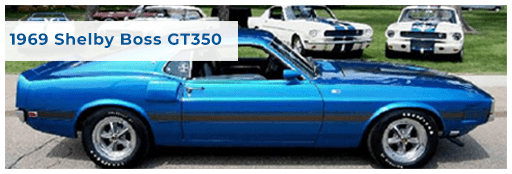302 CID HO Engine

History
After 38 years and nine owners from the build date of May 6, 1969, the Shelby Boss 302 was finally finished. It was featured at the Shelby-Boss reunion on August 10 to 11, 2007, at the Indianapolis Ford plant. The Shelby Boss 302 was to be a 200-car program as documented by the Ford Motor Company, the Shelby American (SAAC) 1999 issue #68, and Marti Auto Works.
Further research shows that nearly 200 were planned for production, but only the prototype vehicle was produced. The Shelby Boss 302’s creation, ownership, and even its existence have been the subject of considerable speculation, but it is real. The information in this article was collected from Ford records, documentation within the car (build sheets), and conversations with previous owners and Carroll Shelby, who refers to this special car as the Shelby-Boss.
The Genesis
The 1969 Boss 302 Shelby was built on a Boss 302 chassis and carried the Shelby VIN 9F02G482244. Shelby confirmed that by 1969, any of his engineers working at Ford could have ordered the pilot car (or a prototype, per Shelby), but they are now gone. Those who shepherded the pilot will likely remain unknown.
Shelby also confirmed that he spent little time with the program. With the introduction of Boss 302 in mid-April 1969, Ford’s interest was clearly shifting to Boss 302, championed by Bunkie Knudson and recently recruited from GM by Henry Ford II. Ford didn’t need two specialty Mustangs when Shelby resigned. This may be the reason why the Boss 302 Shelby program ended.
The Boss 302 Shelby’s scheduled program features 2-door fastbacks, each with a 4-speed transmission and front spoiler. Placing a Boss 302 drive train in a GT 350 was considered a perfect combination and clearly better than the 351 W CID option, which features black trim and a black interior. But with Shelby resigning, the program ended, leaving the Acapulco Blue Shelby all by itself.
Building the Pilot
Ford officials confirm that the Boss 302 Shelby was an executive-ordered car from Ford’s World headquarters in Dearborn, stating that it had an 84 District Special Order (DSO), a home office reserve number only Shelby received. The “G” in the VIN was a Boss engine code, while the “48” confirmed that the pilot was to be a Shelby GT, in this case, a GT 350.
The order DSO item number 9999 further confirms that this was an executive order number from Ford Headquarters. It also received a line ID # 84X999, a number every ‘67, ‘68, and ‘69 Shelby was given.
Instead of going to Southfield, MI, to be completed, the Boss 302 Shelby went to the Kar Kraft Design Center located in Livonia, MI. This is where design engineers and prototypes were housed. Kar Kraft is located in Brighton, MI, and was used for production. Ford’s customer assistance center (CAC999) report shows the 1969 Shelby 2-door fastback built May 6, 1969, with the following options:
By the Numbers
The numbers in the VIN, 9F02G482244, offer additional information. Ford said that “44” as the last two digits in the VIN was an engineer code for a special order car, although it was a consecutive unit number (2243 and 2245 were built). A case in point was a 427-powered 1967 Fairlane ordered by Edsel Ford with a VIN ending in 44.
Another vehicle with a VIN ending in 44 was the 1967 427 Super Snake. How unusual is that? If you are a real number buff, then 22 is (2+2 = 4), and 44 is (4-+4 = 8), or 48 Shelby. The build sheet rotation number is 566, which coincides with the date it was built, which was 5-6-69.
Finishing the Build
The one and only photograph was taken in 1985 at Milan Dragway in Michigan, leaving a burning impression of how the car was supposed to look when it left the factory in 1969. Keep in mind that the photograph was taken fifteen years after it left the factory in ‘69.
In that photo, the description was given by the second owner, J.P., who describes it as just having been painted three days prior to the day that picture was taken. It had been lightly hit in the rear from being pushed after not running. He had braized new quarters and tail light panels prior to painting. However, certain holes and parts prove that it was built as a Shelby. How it left will be a mystery.
The previous owner, Gary Burke, found an extra Shelby fog light switch under the carpet and a complete set (4) of very interesting GT 350 wheel center cap decals in 1990. The build sheet, also under the carpet, was in good condition and confirmed details such as the 84 DSO, the black stripes, and showing it was to receive all Boss 302 parts for the suspension, including:
Special Springs Front and Rear
Staggered Shocks
Big Front Spindles
Reinforced Shock Towers
It sits lower than a Shelby, and with the ‘69 Boss 302 engine, there is a significant difference in handling when compared to a GT 350. Later, Shelby cars received big spindles and tie rod ends only, not Boss 302 springs.
Several years ago, the sixth owner, Bob Gaines, had the car dipped, stripping it of all paint and bondo and exposing both seams where both the quarter and taillight panels had been braized on and a hole in the firewall where the Shelby fog light harness was located.
As the 1969 Boss 302 Shelby was being completed, Shelby was personally contacted to confirm details. For instance, as the car was being completed, every date code on every piece of sheet metal was photographed and recorded. There were nearly 50 found, and 95% were stamped within two weeks of the build date. For example, 4-24-3D indicated April 24, 3rd shift, Dearborn.
Other than replacing the quarter panels, the metal repair was minimal, retaining 75% of the original interior. The transmission has the original 2244 VIN stamped, replacing the original block that was cracked in 1975 due to freezing in Michigan. The car now carries an original C8FE block factory stamped x348. The C7FE steel crank, rods, and heads are original for this Boss 302 engine.
Sign-Off
During the completion of the Boss 302 Shelby, several documents were made available attesting to the fact that 9F02G482244 is authentic. Both Carroll Shelby and Edsel B. Ford II have countersigned documents citing the Boss 302 Shelby as the only Shelby built with a Boss 302 engine. This is an indisputable part of Shelby’s history and legacy.



